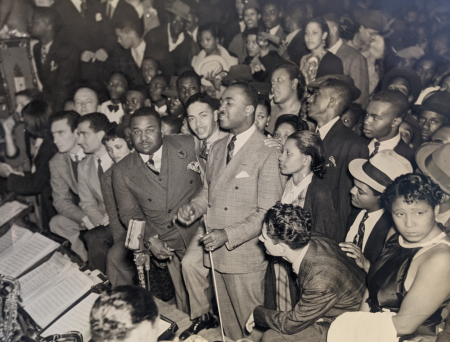.
.

Jimmie Lunceford, c. late 1930s (photographer unknown)
.
___
.
….During a recent spring-cleaning project that involved rummaging through boxes that have been stored in my attic for longer than I care to admit, I came across a box of memorabilia belonging to my father that has been in my possession since my mother’s passing nine years ago.
….My father Joe was a distinguished musician who, before becoming a full-time restauranteur in the late 1950s, led his own big band as a young man in Sacramento, played in the Winged Victory orchestra during World War II, with Merv Griffin at KFRC radio in San Francisco, and with the likes of Jack Fina, Bill Holman, and Ernie Heckscher. I grew up hearing about his meaningful friendships with Joe Bushkin, Roy Eldridge, Henry Mancini, Les Brown, Billy May and David Rose, and witnessed him playing with, among others, Freddy Martin and Nat King Cole.
…..Toward the end of his life, my father wrote a few stories about his experiences as a musician, all typewritten and neatly assembled in a three-ring binder, and discovered in a box marked “Joe Memories.” (As a Father’s Day “gift” to him, I will soon be publishing one of his stories). In addition to this binder, I found several photographs of my dad taken during his time as a musician, including this one I’d never seen before of the great bandleader Jimmie Lunceford, who my father enjoyed listening to and would occasionally talk about. There is no date associated with this photo of Lunceford famously wielding his conducting baton, but it is likely taken in Sacramento, where my father grew up and lived for a time, in the late 1930s. (My father is in the photo, left arm resting on his knee, to Lunceford’s left).
…..It is possible this photograph was taken in Sacramento’s Rainbow Gardens which, according to my dad, booked all the famous bands of the time. (Benny Goodman performed there on July 16, 1937).
…..Beyond the obvious personal connection I feel to the photo, it is interesting on other levels, particularly as a snapshot of social (and likely segregated) life in Sacramento. The photo also inspired me to revisit Lunceford’s biography and particularly the circumstances of his death in 1947 in Seaside, Oregon. Although most accounts dispute this, theories abound that he was poisoned by a racist restaurant owner. In 2017, Seaside Signal editor RJ Marx recounts the circumstances of Lunceford’s death and shares some of the thinking behind the poisoning allegation. You can read it by clicking here.
.
___
.
.
One of Lunceford’s great recordings from 1937 is Don Raye, Vic Schoen and Sy Oliver’s “For Dancers Only,” which features his noted saxophone section led by alto player Willie Smith.
.
.
Click here to be view Lunceford’s Wikipedia page
.
.
.








































The Lunceford band was in Sacramento in the late Fall of 1937, and not again until the Summer of 1940. However this photograph looks like it was taken in the period July 29th – August 1, 1941 at Sweet’s Ballroom, in Sacramento. I will consult my records and provide the exact date shortly. A great pohoto! Thanks, Arthur Farrar, Lunceford historian.